The NYT Magazine has an excellent firsthand report from the set of Red vs. Blue. It turns out that a few scrappy creative types are actually making movies inside of video games. If this catches on, it could be revolutionary. I mean, it’s pretty funny to imagine those faceless soldiers in Halo having inner lives and existential crises. haha.
Now if only this upstart medium had a name…
8/05, 4,500 words: The X-Box Auteurs [nytmag]
Previously: Waiting for Halo; 11/04, like, 100 words: Virtual Warriors Have Feelings, Too [nyt]
Author: greg
Tokyo Snapshots, 1.5: Takashi Murakami Corp.
I still have a place in my heart–and fortunately, a spot in the old collection–for Takashi Murakami. The Louis Vuitton thing was rather masterful, and the sheer superfluity of luxury and fashion maps rather well onto some of the more expendable aspects of contemporary art, too.
Likewise, I’m not unappreciative of Murakami’s own creation myth, in which he and his characters subverted and exploited the banal world of Japanese idol-centric television, even as they were, in turn, exploited by the media for their own ends.
And when the set of Tongari-kun characters, including Mr. Pointy and his crew, was installed at Rockefeller Center, I was happy to go celebrate. [Here’s Gothamist’s report.]
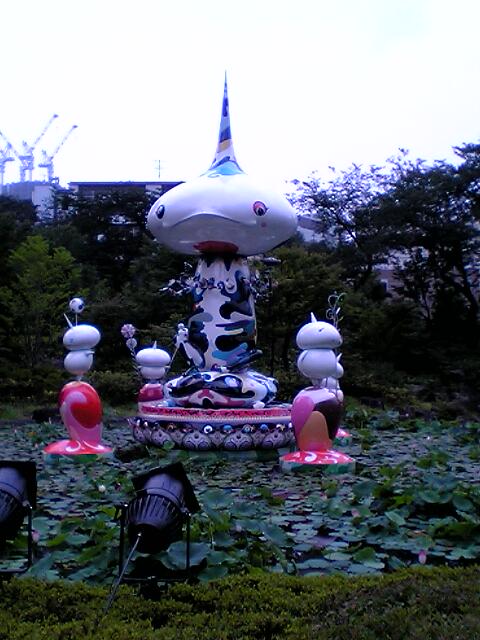
But for some reason, it gives me a creeped out, sinister feeling seeing the identity characters he licensed to the massive, city-soul-sucking Roppongi Hills development, and then seeing the whole place decked out with banners celebrating Murakami Month, aka the same Tongari-kun/ Mr. Pointy sculptures from two years ago, installed in a lotus pond at the complex’s center.
The Mori Art Museum and its adjacent mall are full of Murakami goods, of course, dolls, t-shirts, towels, stickers, but nothing sums up the uncritical celebration of megalomania and the unholy confluence of conscience-free art, urban planning, and commerce better than this: Roppongi Hills Monopoly, featuring Takashi Murakami’s characters. It’s about 5,000 yen. Of course, I bought it.

Tokyo Snapshots, 1.4: Tadao Ando Ruins Omotesando
This is the Tadao Ando building complex that the ego-mad developer Mori Minoru is finishing on Omotesando, what was once the heart of alternative cultural Tokyo. With a slew of LVMH brand glass curtained flagships all around it, it should really complete the look.
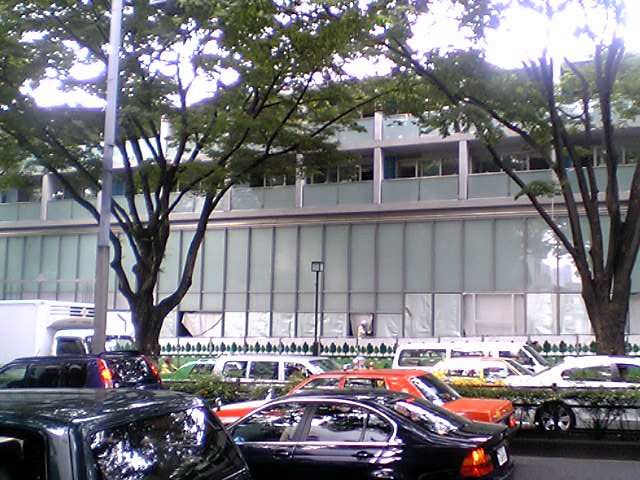
Tokyo Snapshots, 1.3: Sweet Muji Cardboard Shelving
Muji doesn’t inspire ecstatic fandom so much as subdued dedication. Otherwise, I’d turn into a screaming screaming junior high school girl every time I walked into one of their stores.
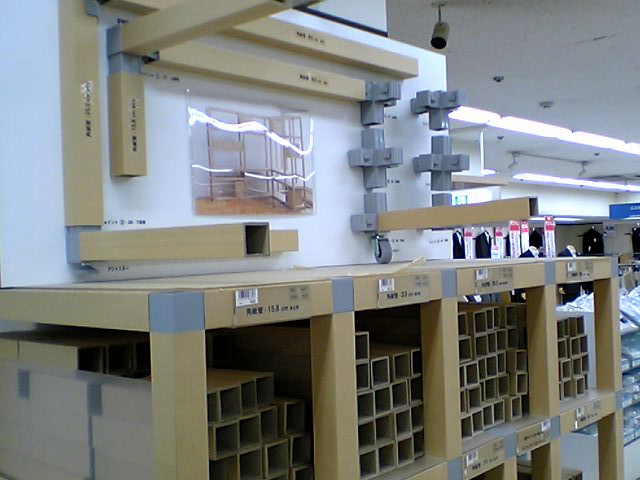
This Muji modular shelving system is one of five Muji products that received International Forum Design Awards in Hannover, Germany this year. Made from stiff, square-edged, recycled cardboard, and flush-fitted matte plastic joints, the system snaps together easily in a myriad of configurations. It’s clean and extremely functional, but yet it’s not thoroughly boring like most shelving. And it’s cheap, too.
You can see all the components online at the Muji net store [in japanese]
Square paper tube rack system [ifdesign.de]
Tokyo Snapshots, 1.2: Kawaii Gravestones
A gravestone shop I pass on the way from the hotel to the supermarket offers cute gravestones as an alternative to the traditional obelisk variety. I asked, and they’re not just for decorating your Japanese garden. Couldn’t bring myself to ask if they actually got permission from Sanrio and Disney for these, though. It didn’t seem polite.
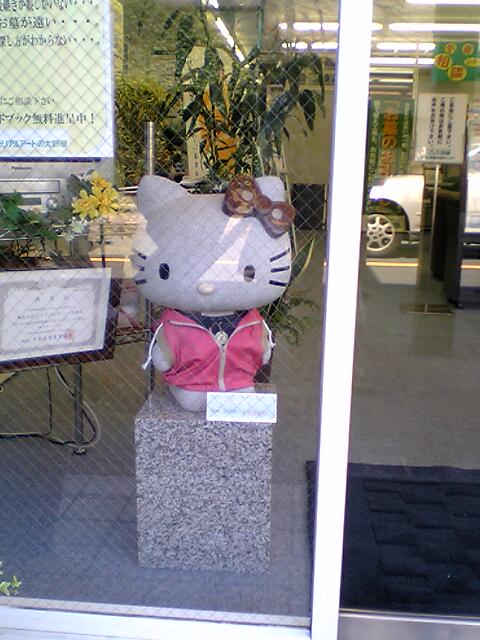

They’re about 140,000 yen each, and look like they were computer-carved from a smaller doll. The Kitty actually has a bow in contrasting red granite, and an actual hoodie, much like Degas’ Dancer has an actual tutu. Yes, I just compared Hello Kitty to Degas.
Tokyo Snapshots, 1.1: BSA Narcommercial
My thumbnail generator’s on the fritz, but here are some pictures I’ve taken around Tokyo using my Sharp TM-150. It’s pretty sweet for a phonecam, because it has a rather rare combination of decent megapixel camera and removable SD memory for cheap and easy mass image transfers.
First up is this Business Software Association commercial running on the Tokyu train:
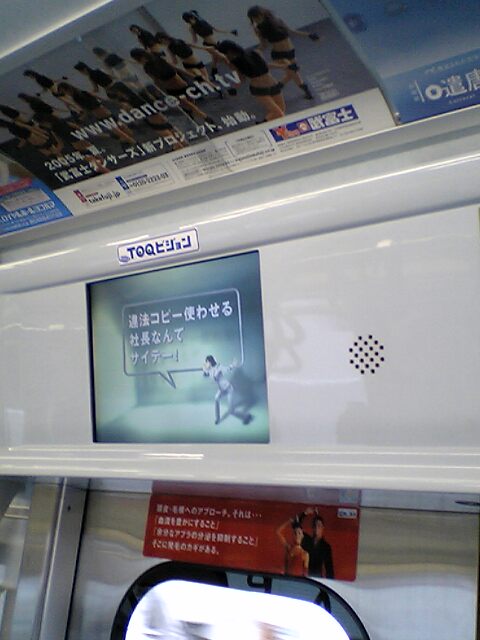
Translation: “Company presidents who make you use illegally copied software are the worst!!”

“Hello, is this BSA?”
A Million Penguin March On Tokyo, Change Trains With Ease, And Are So Over Ape T-Shirts
First of all, this whole Bathing Ape thing? Chill the flip out, people, it’s just not that cool. Bape is just Gap for the overly self-involved.
Anyway, TMN‘s mention of hopstop.com, a site for figuring out subway-to-subway trips in the city, reminds me it’s time to post about Norikae-Annai, aka Transfer Info, which is the same service for Tokyo.
It’s insanely helpful, if not as easy to start using cold; it gives you multiple trip options, indicating the fastest, cheapest, shortest on-train riding time… For untangling the spaghetti bowl that is Tokyo’s train/subway system, it’s pretty much indispensable.
I’ve got picture of Tadao Ando’s controversial new Jingumae apartment buildings nearing completion on Omotesando, the treelined main st of Harajuku. Ando’s concrete grid with a milky glass skin is starting to peek out of the scaffolding. Unfortunately, much of the opposite side of the street is now glass skin, too, so the street’s getting homogenized pretty quick. The interesting part of Ando’s buildings may be the courtyards, though. [Mori–who else?–tore down the Dojunkai Aoyama apartment buildings, revolutionary but crumbling 1927 concrete-and-ivy structures that served as incubators for much of the neighborhood’s alternative art and design scenes over the years. Oh well.]

Those penguins are everywhere. Remind me to include subjects in my next documentary that translate into cute plushtoys, because they have marched into every corner of the city.
On The Train From Tokyo
Around 7 o’clock on a crowded Sunday evening train away from Tokyo’s destination-filled southwest side (Roppongi, Aoyama, Shibuya, etc.), a couple in their late forties/early fifties sat quietly in the car’s corner seat. They were dressed, but not dressed up; he held a slim, pink, rather glossy shopping bag on his lap. They didn’t speak, but just sat quietly and contentedly next to each other. When you know someone that long, that well, a silent train ride home is barely a punctuation mark, an almost imperceptible breath in a decades-long conversation. Is that what it’s like to be old and married, I wonder?
Mamonaku Touka-Ichiba ni tsukimasu. Touka-Ichiba desu. They announce the next station, and the train begins to slow down. The man quietly hands the shopping bag to the woman, and they match glances and slight nods, or was it just the swaying train? No. Eyes forward, he gets up and joins the dozen or so people pressing out door. The woman, bag on lap, looks, not after him, but away, out the window. Not following his exit, she’s a woman who went into the city for the day. Maybe I–no, there’s a ring.
She adopted the precise mid-ground-focused gaze of Tokyo commuters; surrounded by people and ads and scenery and stuff, she expertly looked at nothing. She didn’t move much, except for the rocking of the train, until Machida, when we all shuffled onto the platform. She held the pink shopping bag and a small black purse in the crook of her arm as she left for home.
What Ere Thou Art, Act Well Thy Part
O me of little faith. Richard Dutcher, the guy who made the first Mormon niche film, God’s Army, goes around making sure he’s referred to as “The Mormon Spielberg.” Meanwhile, the guys at HaleStorm seem to have set their sights on becoming “The Mormon Farrelly brothers,” I guess. But with their new film, Church Ball, as they try to break out of the Mormon ghetto they helped define–and saturate with mediocre comedies–I think they’re well on their way to earning the title, “The Mormon Rawson Marshall Thurber,” and they’re welcome to it.
From the NYT puff piece hailing The New Mormon Wave of fogettable cinema:
So far, the price of cultural crossover seemed to be merely good-natured exasperation. As the cameras rolled, an actor unspooled streams of profanity, and Hale had to assure his extras, all Mormon, that the four-letter words would be dubbed over with a ref’s whistle.
The Cinema of Latter-Day Saints [nyt mag]
Also in the NYT Mag: Jim Jarmusch shows how it’s actually done.
Related? A guy who went to high school with Napoleon Dynamite producer Jeremy Coon is trying to out-filmmake him before their 2007 reunion. Good luck with that.
“Films as Found Object”
Stefano Basilico’s well-rounded exhibition on artists’ use of films–not film–as a medium got a nice review from Roberta Smith in the NYT. My absolute favorite piece in the show–which was in Miami last winter–is Christian Marclay’s Video Quartet. But Pierre Huyghe’s smart, touching work, L’Ellipse also stands out for the way it toys with film’s conventions of time and narrative. Huyghe filmed a 10-minute walk across the Seine that was implied by an edit in Wim Wenders’ film, The American Friend. [Smith calls it a jump cut, which it’s technically not. True, the movie jumps from one side of the Seine to the other, but a jump cut is actually a break in time at the same spot or scene.]
A Medium In The Making [nyt]
CUT/ Film As Found Object, at Milwaukee Art Museum through Sept. 11 [mam
Hm. Doesn’t Sound Like Intelligent Design OR Evolution
Santiago Calatrava’s desgin for a WTC site transit hub has been altered for security reasons. The soaring wings and the glass atrium? Gone, filled in with concrete, to match the new “beak” and solid concrete wall surrounding the joing. According to the NYT’s achingly diplomatic David Dunlap, the new design “will almost certainly lose some of its delicate quality, while gaining structural expressiveness. It may now evoke a slender stegosaurus more than it does a bird.”
But didn’t birds evolve from dinosaurs, not the other way around?
Approval Expected Today for Trade Center Rail Hub [nyt]
Amateur Branding Hour: Hedge Fund Naming Strategies
Hedge funds are a lot like trucking companies: they’re usually started by one rather strong-willed guy who gets fed up with his bosses and decides he’s going to work for himself. One of the first things these egotistical entrepreneurs do is come up with a name and an identity for their companies. In both cases, the process is entertainingly amateurish, at least from a branding professional’s perspective.
Trucker logos–which I study regularly from my driver’s seat on the turnpikes between DC and NY–are achingly literal; I can easily imagine a trucker dictating the logo to his “artistic” sister-in-law [“It’s got a map, with a scroll on it, like the Declaration of Independence. And a cross.” “Put my name on a scroll, like the Declaration of Independence.” “It’s gotta be classy, with my coat of arms on it. And old-style writing.”] They’re little windows into what one man sees as important to get across: his ambition, his faith, his name.
So when the Wall Street Journal says hedge fund managers are trying to come up with names that are “soaring, mighty, fast or majestic,” –and that they frequently use their own initials–it feels familiar.
The hedge fund guys who put a lot of time into it also try to sound erudite and exclusive, like they’ve already arrived. They feel their fund’s name must somehow communicate not just their strategy or methodology, but their outlook on life; their firms are extensions of themselves. They try to assure potential investors–high net worth individuals and other fund managers–that they understand how these things are done. They’re a particular kind of unabashed lifestyle marketing, with a personal touch.
And so what’s important to hedge fund managers, besides Greek gods? There are the formative writers from college–I’ve seen Thoreau, Melville and Proust references–they presumably don’t have time to read anymore. But what’s most important to hedge fund guys, it seems–besides themselves–are luxe vacation spots: Aspen; mountains in Maine; that river in Idaho or Argentina where they go fly fishing; the peak near Val d’Isere with the double black diamond helicopter skiing. The Good Life. [thanks, TMN]
Another Unrealized Project: Gregor Schneider’s Venice Cube
 A couple of months ago, I wrote a NYT piece about artists’ unrealized projects. The piece quoted several interviews conducted by the curator Hans Ulrich Obrist, who sees these unrealized projects as under-publicized and under-appreciated aspects of an artist’s work, especially compared to the high level of attention regularly paid to architects’ unbuilt proposals.
A couple of months ago, I wrote a NYT piece about artists’ unrealized projects. The piece quoted several interviews conducted by the curator Hans Ulrich Obrist, who sees these unrealized projects as under-publicized and under-appreciated aspects of an artist’s work, especially compared to the high level of attention regularly paid to architects’ unbuilt proposals.
Well, Gregor Schneider’s Venice Cube 2005 is one piece that’s getting plenty of publicity. Schneider proposed building a large black cube out of scaffolding and fabric in the Piazza San Marco for the Biennale. It was reminiscent of the Kaba’a, which is at the center of Mecca. The proposal was rejected several times by Italian officials for what they now acknowledge were “political reasons,” to use the artist’s description. Schneider wanted to publish his documentation of the piece and the controversy–including emails between government officials and Biennale organizers, but he was forbidden to do so. His entry consists of six all-black pages in protest.
It would be interesting to see those emails. And to see this story get attention beyond The Art Newspaper, a worthy publication though it is.
Art in the age of global terrorism [theartnewspaper.com]
Previously: Unrealized Unrealized Projects
Buy Hans Ulrich Obrist Interviews: Vol. 1 at Amazon
Tokyo Earthquake: We’re Alright
This afternoon just after 4:30, we heard a low rumble and felt everything sway and tremble for about 15-20 seconds. It was strong enough to make you stabilize yourself, but not so powerful that people realized it right away.
We were at Open Campus Day at ISAS/JAXA, the Japanese Aerospace Agency’s mission control center for Jean’s X-ray telescope satellite, Suzaku. We were in the lobby of the building; the sheet glass handrails along the central staircase all wavered back and forth throughout the quake.
In the mean time, a bunch of train lines across the Tokyo region were shut down, which backed up human traffic, even to Machida, on the west side of Tokyo. [Of course, watching the news, it turns out that Yokohama, on our side of Tokyo Bay, and opposite the epicenter, registered at least a 5 on the Richter scale.]
Anyway, the only real effect we’ve had is having to heft the stroller up five flights of stairs at the hotel because the elevators aren’t working anywhere.
To: The Prada Hataz Crew
 A report from the Herzog & deMeuron-designed Prada store in Tokyo’s Minami Aoyama neighborhood. I have some good news and some bad news.
A report from the Herzog & deMeuron-designed Prada store in Tokyo’s Minami Aoyama neighborhood. I have some good news and some bad news.
First the bad news. It was reported earlier that the store smelled like feet cat urine. It appears this is no longer the case. The white carpets seemed freshly–and repeatedly–shampooed, which may explain the lack of odor.
Also, I saw no evidence to support reports that the windows were cracking and popping out, and that the clothes were fading at an excessive rate.
Worst of all, it’s actually quite nice, much nicer than the Rem Koolhaas fiasco, anyway.
Now the good news: we were the only customers in the store during the entire time we were there. Also, the kid’s all-terrain stroller left calligraphic trails in the untrodden carpet.
Prada Tokyo images at Dezain.net
previously: “damn, but that company pisses me off.”
